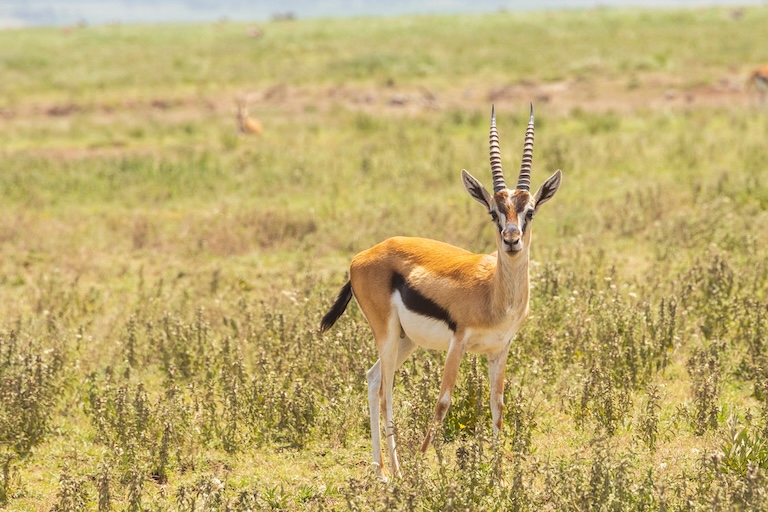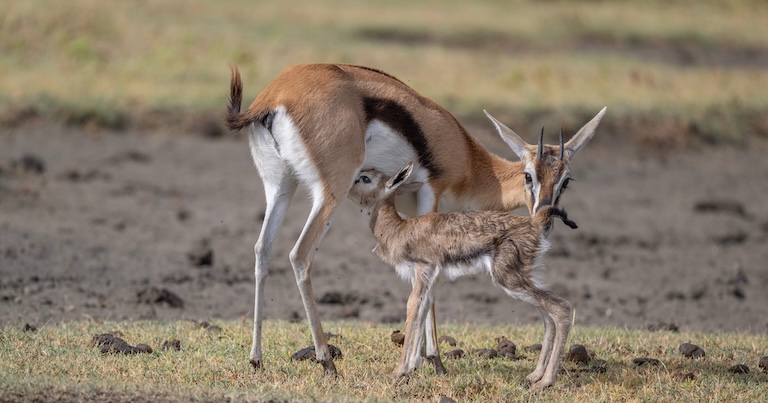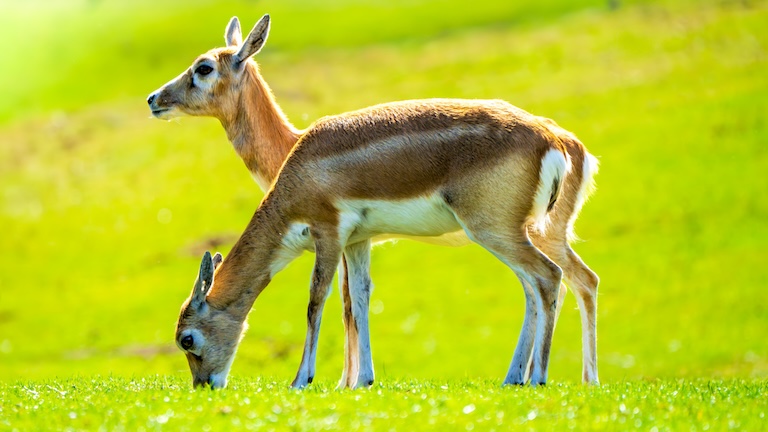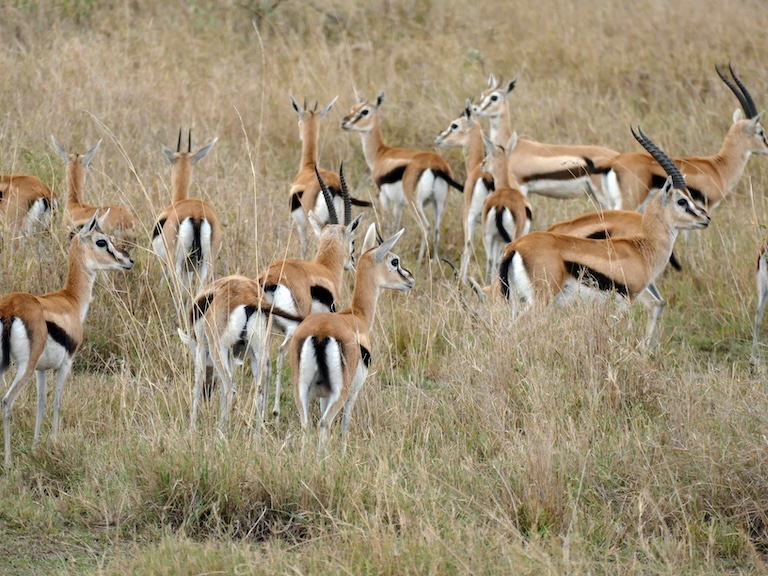Thomson’s Gazelle Profile
The pronghorn, from North America, is one of the fastest animals on land, and since evolution only provides the bare necessities, it might be a little difficult to intuit why it needs to be this fast.
The reality is that it bears an evolutionary mark from its ancestry, which was at one time plagued by cheetahs.
The cheetahs in North America are all extinct now, but the pronghorn retains the speed it evolved in defence against them.
Unfortunately for the Thomson’s gazelle, cheetahs are alive and well in Africa still, so their incredible speed and agility are often put to the test, yet they often pass with flying colours.

Thomson’s Gazelle Facts Overview
| Habitat: | Savanna and grassland |
| Location: | East Africa |
| Lifespan: | 15 years in the wild, 20 in captivity |
| Size: | Up to 70 cm (28 in) tall |
| Weight: | Up to 35 kg (77 lb) |
| Colour: | Sandy brown with a black band along the side and a white belly and throat |
| Diet: | Grasses, trees, shrubs |
| Predators: | Cheetahs, lions, leopards, crocodiles, hyenas, jackals, baboons. |
| Top Speed: | 90 km/h (55 mph) |
| No. of Species: | 1 |
| Conservation Status: | Least Concern (IUCN) |
Thomson’s gazelles are a taxonomic entanglement that forces us to redefine what a gazelle actually is. But this is all semantics: the antelope doesn’t mind what you call it and can outrun even the most targeted of criticisms as one of the nippiest animals on the planet.
They’re not just fast though, they’re also tough, and they band together in huge numbers and with lots of larger friends for additional safety.
While their numbers have dropped significantly, they’re still a healthy population today, albeit a relatively small one.
Interesting Thomson’s Gazelle Facts
1. They’re not really gazelles?
This is a bit pedantic, since it’s a common naming scheme, but true gazelles were once all grouped under the genus Gazella, which is simple enough to understand.
Since then, better research has determined that several subgroups within Gazella deserve their own genera, and now there are also two other genera alongside Gazella: Nanger, which contains Grant’s and Dama gazelles, and Eudorcas, which is home to the red-fronted and Thomson’s gazelles.
Incidentally, Eudorcas is also what children in Ancient Greece would shout at one another for being socially inept, but in this instance, it means “true dorcas” which confuses matters since the docas is still a member of the Gazella genus.
It’s perhaps not fair to say Thomson’s gazelles aren’t true gazelles, but their taxonomy remains pretty convoluted, and there’s even a raging debate around whether it’s just a subspecies of red-fronted gazelle, so it’s likely to change even more in the future.
But regardless of their genetic makeup, Thomson’s gazelles are tough little antelopes.

2. They’re hot weather specialists
One thing this species is very good at is staying hydrated. These are hot grassland and savanna animals and have developed adaptations for coping during times of little water.
While they are entirely dependent on water – unlike some species who can get all their moisture from food – these little antelope can slow down their metabolism in times of scarcity, and it’s pretty obvious that they’re much better equipped for this lifestyle than their domesticated counterparts when it comes to the efficiency of their digestion.
This also allows them to stick around when others need to leave. 1
3. They outlast other herbivores
In Kenya and Tanzania, Thomson’s gazelles are some of the last to move out of the grasslands during the dry season.
They adjust their diet from grazing to browsing depending on the conditions, but their drought tolerance also allows them to stay out in the field for longer than most.
They will move eventually, often following the wildebeest and zebra migratory patterns, making use of the extra support against predators and proving themselves as community members. 2
4. They’re social
This small animal often hangs out with some of the larger herbivores but it’s also social among its conspecifics.
There are various forms of Thomson’s herds, ranging from all-female, through mixed to bachelor herds, but there doesn’t appear to be a set hierarchy among them.
Usually, the strongest male will defend a territory against rivals, but this sometimes ends in a scuffle, in which the toughness of this small bovid is tested. Males will crash and lock horns and push back and forth, though they are rarely injured.
After their battle, they will end with a little grazing ritual in which both will eat some grass in front of one another to show that the fight is over. 3
5. They’re gregarious
To avoid all this fighting and grazing, males set up territories using scent marking. If they’re close enough they’ll also show off their muscles in dominant displays, but usually, a boundary is marked with secretions and then patrolled.
A male can have upwards of 50 females to protect, which sounds exhausting enough, but this configuration is nothing compared with some of the largest mixed herds, which can number as many as 200,000.
This extreme figure is rare, though numbers do frequently enter the thousands.
In these enormous gatherings, there is much less of a clear dominant leader, and members will come and go more flexibly.

6. They’re vigilant
Safety in numbers comes from thousands of eyes scanning the grasslands for predators. And the gazelles are not short of enemies in this regard.
All the big cats, dogs, jackals, and even hyenas and baboons have such a small animal as the Thomson’s gazelle on their menu.
As a result, these guys are highly alert and pay a lot of attention. They are not easy to sneak up on, especially in large numbers, and when their keen senses pick something out, they can run like the dickens, as Grandma would say. 4
7. They’re fast
It’s said that this is the fourth-fastest land animal after the springbok and pronghorn antelopes and the infamous cheetah.
When startled, the Thomson’s gazelle accelerates quickly and hits its top speed after a few seconds, after which it relies on its smaller size to dodge the slightly faster cheetah by changing direction rapidly. 5
8. They’re doing okay for now
This is a species highly adapted to predation, so the major threats are all from humans. From 1978 to 2005 their populations tanked by 60% and they’re not found mainly in strongholds like the Masai Mara and the Ngorongoro Conservation Area in Tanzania.
As of 2018, the population is estimated at around 145,000 and is still in decline, but in terms of genetic health, this isn’t of concern to conservationists yet.
There is some evidence that wildebeest populations have an inverse effect on this species, but it’s not clear yet why that is.

Thomson’s Gazelle Fact-File Summary
Scientific Classification
| Kingdom: | Animalia |
| Phylum: | Chordata |
| Class: | Mammalia |
| Order: | Artiodactyla |
| Family: | Bovidae |
| Genus: | Eudorcas |
| Species: | thomsonii |
Fact Sources & References
- G M O Maloiy (2008), “Effects of dehydration and heat stress on food intake and dry matter digestibility in East African ruminants”, PubMed.
- “Thomson’s Gazelle”, IUCN Red List.
- “Thomson’s Gazelle”, MPALA Live.
- “Thomson’s Gazelle”, African Wildlife Foundation.
- Best of Wildlife (2021), “Speed of Thomson’s gazelle”, YouTube.
